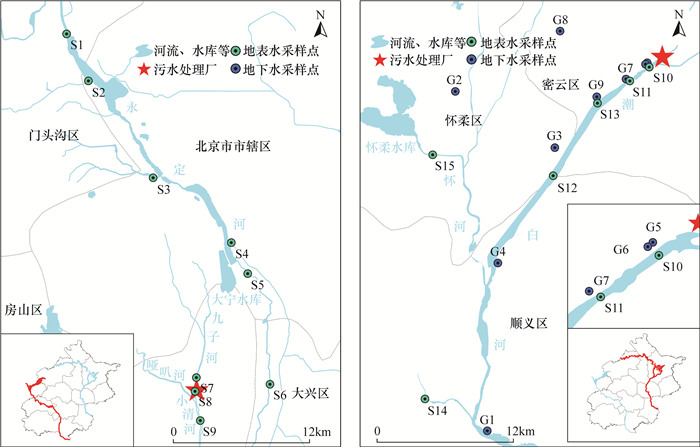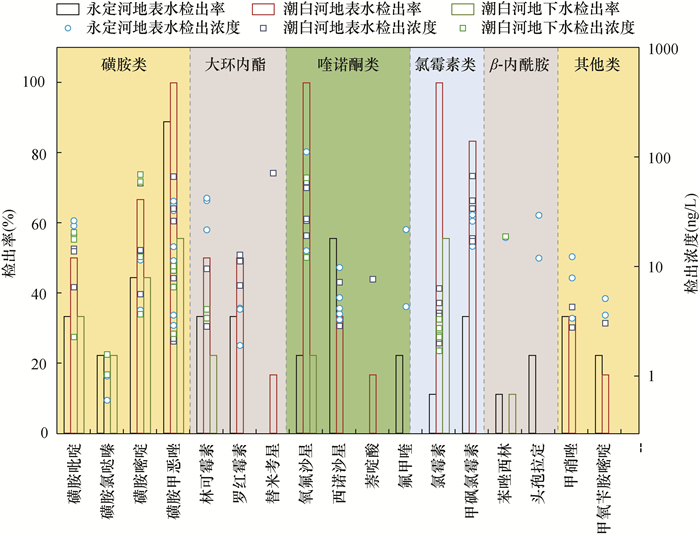Determination of 37 Typical Antibiotics by Liquid Chromatography-Triple Quadrupole Mass Spectrometry
-
摘要:
目前抗生素的环境检出受到人们的广泛关注,但能够同时测试地表水和地下水中七大类抗生素的方法仍较为缺乏。本文采用超高效液相色谱-串联三重四极杆质谱法(UPLC-MS/MS),建立了同时测定地表水和地下水中磺胺类、四环素类、大环内酯类、喹诺酮类、氯霉素类、β-内酰胺类和其他类共七大类37种抗生素的分析方法。该方法对水中抗生素有较好的富集作用及灵敏度,检出限为0.6~10.6ng/L,基质加标回收率大多为60%~130%。采用本方法测定了北京市永定河地表水、潮白河地表水及潮白河流域地下水中的抗生素。结果表明:永定河地表水中以磺胺类、喹诺酮类和大环内酯类为主,检出率分别为88.9%、55.6%和33.3%,其中氧氟沙星的最大值为111.9ng/L;潮白河地表水中磺胺类、喹诺酮类和氯霉素类抗生素的检出率均为100%,其中替米考星的浓度高达71.6ng/L;潮白河流域地下水中以磺胺类、喹诺酮类和β-内酰胺类抗生素为主,检出率分别为66.7%、55.6%和22.2%,磺胺嘧啶的最大值为69.3ng/L。污水处理厂附近样品中抗生素的检出率及浓度均明显高于其他点位。本研究建立的方法简单、快速、准确,为地表水和地下水中的抗生素监测提供方法支撑,为水资源的合理利用及水中新污染物的治理提供了科学依据。
-
关键词:
- 抗生素 /
- 超高效液相色谱-串联三重四极杆质谱法 /
- 地下水 /
- 地表水 /
- 北京市
Abstract:BACKGROUND Currently, the environmental detection of antibiotics is receiving extensive attention, but there is still a lack of methods that can simultaneously analyze seven categories of antibiotics in surface water and groundwater.
OBJECTIVES To establish a method that can detect thirty-seven antibiotics (15 sulfonamides, 2 tetracyclines, 3 macrolides, 8 quinolones, 2 chloramphenicols, 2 β-lactams and 5 other kinds) simultaneously.
METHODS Solid phase extraction coupled with ultra-performance liquid chromatography-triple quadrupole mass spectrometry (UPLC-MS/MS) was used to quantify the concentration of antibiotics.
RESULTS The method had good sensitivity and enrichment effect for the surface water and groundwater, the recoveries ranged from 60% to 130%, the detection limits ranged from 0.6 to 10.6ng/L. The method was applied to the determination of antibiotics in surface water of the Yongding and Chaobai Rivers, and groundwater of the Chaobai River in Beijing. Sulfonamides, quinolones and macrolides were the main antibiotics in the surface water of the Yongding River, and the detection rates were 88.9%, 55.6% and 33.3%, respectively. The highest concentration of floxacin was 111.9ng/L. Sulfonamides, quinolones and chloramphenicols were the main antibiotics in the surface water of the Chaobai River with detection rates of 100%. The highest concentration of tilmicosin was 71.6ng/L. Sulfonamides, quinolones and β-lactams antibiotics were the main antibiotics in the groundwater of the Chaobai River Basin, and the detection rates of were 66.7%, 55.6% and 22.2%, respectively. The highest concentration of sulfadiazine was 69.3ng/L. In both surface water and groundwater, the detection rate and concentration near the sewage treatment plant were significantly higher than those at other points.
CONCLUSIONS The method established in this study is simple, rapid and accurate, which can be used for the simultaneous determination of 37 antibiotics in seven categories in surface water and groundwater. It provides antibiotic analysis method support for surface water and groundwater investigation, and provides a scientific basis for rational utilization of water resources and management of new pollutants in water.
-

-
表 1 37种抗生素的定量内标和质谱参数
Table 1. Quantitative internal standard and mass spectrometric parameters of 37 antibiotics
抗生素类别 抗生素名称 英文缩写 内标 母离子m/z 锥孔电压(V) 子离子1/碰撞能(V) 子离子2/碰撞能(V) 磺胺类 磺胺二甲基嘧啶 SM2 SPD-13C6 279.22 56 124.18/22 186.15/15 磺胺醋酰 SA SPD-13C6 215.03 4 156.00/10 108.00/20 磺胺吡啶 SPD SPD-13C6 250.19 32 156.10/14 92.15/26 磺胺二甲氧嘧啶 SDM SCPD-13C6 311.08 2 155.98/18 92.07/30 磺胺二甲异噁唑 SIZ SPD-13C6 268.08 2 156.00/12 113.08/14 磺胺多辛 SDO SCPD-13C6 311.11 2 155.97/18 92.06/28 磺胺氯哒嗪 SCPD SCPD-13C6 284.99 4 155.97/14 92.06/28 磺胺苯吡唑 SPP SCPD-13C6 315.20 48 92.10/38 158.17/28 磺胺噻唑 ST SPD-13C6 256.16 32 92.05/26 156.05/14 磺胺嘧啶 SD SPD-13C6 251.08 72 92.05/24 156.05/14 磺胺间甲氧嘧啶 SMM SPD-13C6 280.77 80 92.01/26 155.92/16 磺胺甲基嘧啶 SM1 SCPD-13C6 264.84 2 155.92/16 92.00/24 磺胺喹恶啉 SQ SPD-13C6 301.24 24 92.11/32 156.03/16 磺胺甲恶唑 SMZ SPD-13C6 254.24 26 92.12/24 156.04/14 磺胺甲氧哒嗪 SMP SCPD-13C6 281.09 2 92.07/28 155.99/16 四环素类 四环素 TC DEOCY 445.15 2 410.21/18 154.11/26 土霉素 OTC 461.10 6 426.22/18 443.32/12 大环内酯类 林可霉素 LIN ERY-13C6-D6 407.32 52 126.25/26 359.36/16 罗红霉素 ROX 837.51 40 158.20/30 679.54/18 替米考星 TIL 869.74 12 88.07/72 174.17/40 喹诺酮类 沙拉沙星 SAR ERY-13C6-D6 385.77 2 299.01/26 348.00/32 吡哌酸 PPA DIF-D3 304.29 40 217.24/20 189.19/30 氟罗沙星 FLE DIF-D3 370.31 64 326.30/18 269.25/26 氧氟沙星 OFL DIF-D3 362.74 42 318.26/17 261.22/26 西诺沙星 CIN DIF-D3 263.25 10 245.19/15 217.21/20 萘啶酸 NDA DIF-D3 232.21 38 215.19/16 187.20/24 噁喹酸 OXA DIF-D3 262.20 2 244.21/18 216.01/30 氟甲喹 FLU DIF-D3 262.19 44 202.16/30 244.20/16 氯霉素类 氯霉素 CAP DEOCY 305.00 2 275.00/14 165.00/25 甲砜氯霉素 TAP 355.97 46 228.92/24 73.11/22 β-内酰胺类 苯唑西林 MRSA DEOCY 401.95 68 143.95/30 242.99/20 头孢拉定 CED 349.81 12 157.93/8 91.02/44 其他类 噻苯唑 TBZ DEOCY 202.15 20 131.07/28 175.08/22 甲硝唑 MTZ 172.12 32 56.11/16 82.04/20 甲氧苄胺嘧啶 TMP 290.78 2 229.98/22 123.05/28 硝呋酚酰肼 NIF 276.19 36 93.04/38 121.04/16 卡巴多 CBX 263.23 36 90.09/26 231.15/12 表 2 不同水基质中各抗生素加标回收率的平均值和方法检出限
Table 2. Average recoveries of antibiotics in different aqueous matrixes and detection limits
抗生素名称 空白检出浓度(ng/L) 回收率(%) 方法检出限(ng/L) 方法检出限配制浓度(ng/L) 超纯水加标(n=3) 地表水加标(n=2) 地下水加标(n=2) 磺胺二甲基嘧啶 ND 80.8 81.6 76.8 2.1 5 磺胺醋酰 ND 82.2 79.3 83.2 1.8 5 磺胺吡啶 ND 77.5 65.3 92.3 3.1 5 磺胺二甲氧嘧啶 ND 79.3 83.5 86.1 1.3 5 磺胺二甲异噁唑 ND 73.5 64.8 92.4 2.8 5 磺胺多辛 ND 81.4 66.5 94.8 1.9 5 磺胺氯哒嗪 ND 78.9 69.9 75.7 0.6 5 磺胺苯吡唑 ND 76.2 62.7 90.9 1.6 5 磺胺噻唑 ND 76.4 90.7 90.7 1.9 5 磺胺嘧啶 ND 80.9 58.8 94.6 3.1 5 磺胺间甲氧嘧啶 ND 65.9 57.1 96.3 1.8 5 磺胺甲基嘧啶 ND 78.7 95.3 90.5 1.5 5 磺胺喹恶啉 ND 77.7 76.4 80.7 2.0 5 磺胺甲恶唑 ND 77.6 74.7 97.3 2.0 5 磺胺甲氧哒嗪 ND 68.8 63.5 96.3 3.0 5 四环素 ND 89.0 112.9 114.8 2.4 15 土霉素 ND 107.0 103.6 66.0 1.6 15 林可霉素 ND 84.9 91.5 82.3 2.8 5 罗红霉素 ND 67.7 70.9 69.6 0.8 5 替米考星 ND 66.8 64.3 57.7 2.1 5 沙拉沙星 ND 84.5 53.9 55.3 3.4 15 吡哌酸 ND 100.8 71.3 94.3 2.0 15 氟罗沙星 ND 76.6 76.2 102.5 8.3 15 氧氟沙星 ND 97.0 87.8 88.0 6.1 15 西诺沙星 ND 105.8 118.3 128.3 1.8 15 萘啶酸 ND 82.8 105.7 118.6 4.4 15 噁喹酸 ND 99.8 74.8 75.1 2.3 15 氟甲喹 ND 97.0 104.9 117 2.5 15 氯霉素 ND 74.0 40.7 70.8 1.6 15 甲砜氯霉素 ND 72.0 131.2 83.8 14.7 15 苯唑西林 ND 64.5 66.5 50.6 7.4 15 头孢拉定 ND 35.3 13.4 23.4 1.7 15 噻苯唑 ND 71.8 59.7 73.3 2.4 5 甲硝唑 ND 39.0 40.5 35.0 1.8 5 甲氧苄胺嘧啶 ND 75.9 73.1 58.9 2.6 5 硝呋酚酰肼 ND 80.3 65.5 94.8 4.6 5 卡巴多 ND 70.9 65.3 97.5 10.6 15 注:ND表示未检出。 -
[1] 祁彦洁, 刘菲. 地下水中抗生素污染检测分析研究进展[J]. 岩矿测试, 2014, 33(1): 1-11. doi: 10.3969/j.issn.0254-5357.2014.01.002 http://www.ykcs.ac.cn/article/id/219a9a71-edb5-4da4-bf01-ee19b6961b6b
Qi Y J, Liu F. Analysis of antibiotics in groundwater: A review[J]. Rock and Mineral Analysis, 2014, 33(1): 1-11. doi: 10.3969/j.issn.0254-5357.2014.01.002 http://www.ykcs.ac.cn/article/id/219a9a71-edb5-4da4-bf01-ee19b6961b6b
[2] Huang F Y, An Z Y, Moran M J, et al. Recognition of typical antibiotic residues in environmental media related to groundwater in China (2009—2019)[J]. Journal of Hazardous Materials, 2020, 399: 122813. doi: 10.1016/j.jhazmat.2020.122813
[3] Zhang Q Q, Ying G G, Pan C G, et al. Comprehensive evaluation of antibiotics emission and fate in the river basins of China: Source analysis, multimedia modeling, and linkage to bacterial resistance[J]. Environmental Science & Technology, 2015, 49(11): 6772-6782.
[4] Hagenbuch I M, Pinckney J L. Toxic effect of the combined antibiotics ciprofloxacin, lincomycin, and tylosin on two species of marine diatoms[J]. Water Research, 2012, 46(16): 5028-5036. doi: 10.1016/j.watres.2012.06.040
[5] Chen L P, Huang F Y, Zhang C, et al. Effects of norfloxacin on nitrate reduction and dynamic denitrifying enzymes activities in groundwater[J]. Environmental Pollution, 2021, 273: 116492. doi: 10.1016/j.envpol.2021.116492
[6] Hoai T D, Trang T T, Tuyen N V, et al. Aeromonas veronii caused disease and mortality in channel catfish in Vietnam[J]. Aquaculture, 2019, 513: 734425. doi: 10.1016/j.aquaculture.2019.734425
[7] Huang F Y, Zou S Z, Deng D D, et al. Antibiotics in a typical karst river system in China: Spatiotemporal variation and environmental risks[J]. Science of the Total Environment, 2019, 650: 1348-1355. doi: 10.1016/j.scitotenv.2018.09.131
[8] Duan L, Zhang Y Z, Wang B, et al. Characteristics of pharmaceutically active compounds in surface water in Beijing, China: Occurrence, spatial distribution and biennial variation from 2013 to 2017[J]. Environmental Pollution, 2020, 264: 114753. doi: 10.1016/j.envpol.2020.114753
[9] 朱帅, 沈亚婷, 贾静, 等. 环境介质中典型新型有机污染物分析技术研究进展[J]. 岩矿测试, 2018, 37(5): 586-606. http://www.ykcs.ac.cn/article/doi/10.15898/j.cnki.11-2131/td.201603300054
Zhu S, Shen Y T, Jia J, et al. Review on the analytical methods of typical emerging organic pollutants in the environment[J]. Rock and Mineral Analysis, 2018, 37(5): 586-606. http://www.ykcs.ac.cn/article/doi/10.15898/j.cnki.11-2131/td.201603300054
[10] 董恒涛, 姚劲挺, 郝红元, 等. 超高效液相色谱三重四极杆质谱联用法测定地表水中14种喹诺酮类抗生素残留[J]. 环境化学, 2018, 37(6): 1436-1439. https://www.cnki.com.cn/Article/CJFDTOTAL-HJHX201806029.htm
Dong H T, Yao J T, Hao H Y, et al. Determination of 14 quinolones residues in surface water by UHPLC-MS/MS[J]. Environmental Chemistry, 2018, 37(6): 1436-1439. https://www.cnki.com.cn/Article/CJFDTOTAL-HJHX201806029.htm
[11] 朱峰, 吉文亮, 阮丽萍, 等. 高效液相色谱-质谱联用法同时检测水体中13种β-内酰胺类药物残留[J]. 色谱, 2016, 34(3): 299-305. https://www.cnki.com.cn/Article/CJFDTOTAL-SPZZ201603012.htm
Zhu F, Ji W L, Ruan L P, et al. Simultaneous determination of 13 β-lactam residues in water by high performance liquid chromatography tandem mass spectrometry[J]. Chinese Journal of Chromatography, 2016, 34(3): 299-305. https://www.cnki.com.cn/Article/CJFDTOTAL-SPZZ201603012.htm
[12] Xue Q, Qi Y J, Liu F. Ultra-high performance liquid chromatography-electrospray tandem mass spectrometry for the analysis of antibiotic residues in environmental waters[J]. Environmental Science & Pollution Research International, 2015, 22(21): 16857.
[13] 马健生, 王卓, 张泽宇, 等. 哈尔滨市地下水中29种抗生素分布特征研究[J]. 岩矿测试, 2021, 40(6): 944-953. http://www.ykcs.ac.cn/article/doi/10.15898/j.cnki.11-2131/td.202101040001
Ma J S, Wang Z, Zhang Z Y, et al. Study on distribution characteristics of 29 antibiotics in groundwater in Harbin[J]. Rock and Mineral Analysis, 2021, 40(6): 944-953. http://www.ykcs.ac.cn/article/doi/10.15898/j.cnki.11-2131/td.202101040001
[14] Zou S Z, Huang F Y, Chen L, et al. The occurrence and distribution of antibiotics in the karst river system in Kaiyang, southwest China[J]. Water Science and Technology-Water Supply, 2018, 18(6): 2044-2052. doi: 10.2166/ws.2018.026
[15] 郎杭. 地下水中典型药物定性识别及抗生素定量的方法研究与应用[D]. 北京: 中国地质大学(北京), 2020.
Lang H. Pharmaceutical identification and antibiotics detection in groundwater[D]. Beijing: China University of Geosciences (Beijing), 2020.
[16] Jiang M X, Wang L H, Ji R. Biotic and abiotic degradation of four cephalosporin antibiotics in a lake surface water and sediment[J]. Chemosphere, 2010, 80(11): 1399-1405. doi: 10.1016/j.chemosphere.2010.05.048
[17] Volmer D A, Hui J P M. Study of erythromycin A decomposition products in aqueous solution by solid-phase microextraction/liquid chromatography/tandem mass spectrometry[J]. Rapid Communications in Mass Spectrometry, 1998, 12(3): 123-129. doi: 10.1002/(SICI)1097-0231(19980214)12:3<123::AID-RCM126>3.0.CO;2-4
[18] Baran W, Sochacka J, Wardas W. Toxicity and biodegradability of sulfonamides and products of their photocatalytic degradation in aqueous solutions[J]. Chemosphere, 2006, 65(8): 1295-1299. doi: 10.1016/j.chemosphere.2006.04.040
[19] Lapworth D J, Baran N, Stuart M E, et al. Emerging organic contaminants in groundwater: A review of sources, fate and occurrence[J]. Environmental Pollution, 2012, 163: 287-303. doi: 10.1016/j.envpol.2011.12.034
[20] Zhou L J, Ying G G, Liu S, et al. Simultaneous determination of human and veterinary antibiotics in various environmental matrices by rapid resolution liquid chromatography-electrospray ionization tandem mass spectrometry[J]. Journal of Chromatography A, 2012, 1244: 123-138. doi: 10.1016/j.chroma.2012.04.076
[21] Ying J L, Qin X P, Zhang Z H, et al. Removal of lincomy-cin from aqueous solution by birnessite: Kinetics, mechanism, and effect of common ions[J]. Environmental Science and Pollution Research, 2021, 28(3): 3590-3600. doi: 10.1007/s11356-020-10766-4
[22] 朱琳, 张远, 渠晓东, 等. 北京清河水体及水生生物体内抗生素污染特征[J]. 环境科学研究, 2014, 27(2): 139-146. https://www.cnki.com.cn/Article/CJFDTOTAL-HJKX201402005.htm
Zhu L, Zhang Y, Qu X D, et al. Occurrence of antibiotics in aquatic plants and organisms from Qing River, Beijing[J]. Research of Environmental Sciences, 2014, 27(2): 139-146. https://www.cnki.com.cn/Article/CJFDTOTAL-HJKX201402005.htm
[23] 章琴琴. 北京温榆河流域抗生素污染分布特征及源解析研究[D]. 重庆: 重庆大学, 2012.
Zhang Q Q. Determination and source apportionment of three classes of antibiotics in Beijing Wenyu Rivers[D]. Chongqing: Chongqing University, 2012.
[24] 方龙飞, 魏群山, 王元宏, 等. 上海黄浦江上游典型抗生素来源及分布污染特征研究[J]. 环境污染与防治, 2017, 39(3): 301-306. https://www.cnki.com.cn/Article/CJFDTOTAL-HJWR201703015.htm
Fang L F, Wei Q S, Wang Y H, et al. Source and distribution of typical antibiotics in the Upper Huangpu River, Shanghai[J]. Environmental Pollution & Control, 2017, 39(3): 301-306. https://www.cnki.com.cn/Article/CJFDTOTAL-HJWR201703015.htm
[25] 周志洪, 赵建亮, 魏晓东, 等. 珠江广州段水体抗生素的复合污染特征及其生态风险[J]. 生态环境学报, 2017, 26(6): 1031-1041. https://www.cnki.com.cn/Article/CJFDTOTAL-TRYJ201706018.htm
Zhou Z H, Zhao J L, Wei X D, et al. Co-occurrence and ecological risk of antibiotics insurface water of Guangzhou Section of Pearl River[J]. Ecology and Environmental Sciences, 2017, 26(6): 1031-1041. https://www.cnki.com.cn/Article/CJFDTOTAL-TRYJ201706018.htm
[26] Du S, Ben W W, Strobel B W, et al. Occurrence, source estimation and risk assessment of pharmaceuticals in the Chaobai River characterized by adjacent land use[J]. Science of the Total Environment, 2020, 712: 134525. doi: 10.1016/j.scitotenv.2019.134525
[27] 吴苗苗. 再生水回灌过程中典型磺胺类抗生素的行为特性研究[D]. 北京: 清华大学, 2015.
Wu M M. The behavior of typical sulfanomides in soil by groundwater recharge with reclaimed water[D]. Beijing: Tsinghua University, 2015.
[28] Hanna N, Sun P, Sun Q, et al. Presence of antibiotic resi-dues in various environmental compartments of Shandong Province in eastern China: Its potential for resistance development and ecological and human risk[J]. Environment International, 2018, 114: 131-142. doi: 10.1016/j.envint.2018.02.003
[29] Zhang C H, Wang L L, Gao X Y, et al. Antibiotics in WWTP discharge into the Chaobai River, Beijing[J]. Archives of Environmental Protection, 2016, 42(4): 48-57. doi: 10.1515/aep-2016-0036
-




 下载:
下载:
